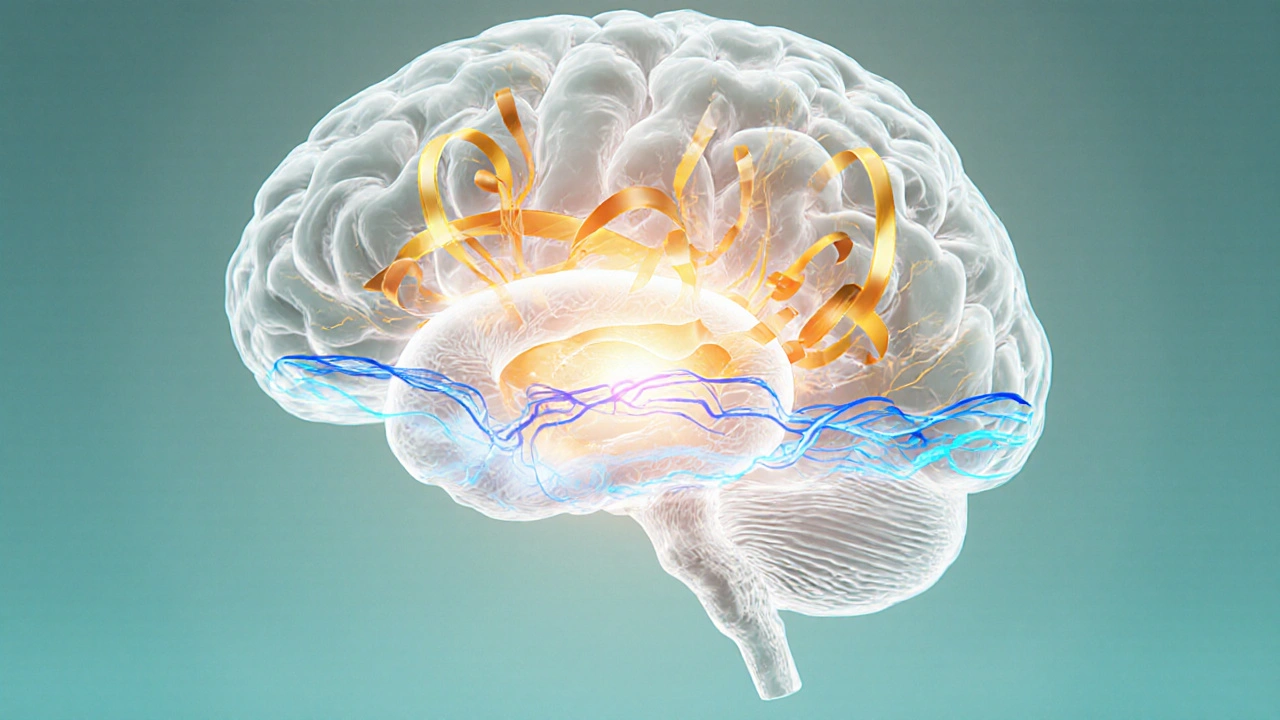Laughter Therapy Benefits for Dementia Patients
 Oct, 4 2025
Oct, 4 2025
Laughter Therapy Benefits Calculator
Estimated Benefits:
Key Benefits Explained
Mood Enhancement
Laughter therapy increases oxytocin and endorphins, promoting positive emotions and reducing anxiety.
Cognitive Support
Repeated laughter stimulates neuroplasticity, potentially slowing cognitive decline through new neural pathways.
Stress Relief
Reduces cortisol levels, offering a natural break from chronic stress that impacts brain health.
Social Connection
Encourages group participation and interaction, combating isolation and improving quality of life.
Key Takeaways
- Laughter therapy boosts mood, reduces stress hormones and improves social interaction for people living with dementia.
- Regular sessions can slow cognitive decline by stimulating neuroplastic pathways.
- Caregivers report lower burnout when they incorporate playful laughter activities into daily routines.
- Evidence supports short, twice‑weekly sessions as a cost‑effective complement to medical treatment.
- Starting simple-watching funny videos or guided giggle exercises-makes adoption easy for home and care‑home settings.
What Is Laughter Therapy?
When it comes to Laughter Therapy is a non‑pharmacologic intervention that uses intentional laughter activities to promote physical and emotional wellbeing, the buzz is real. Unlike spontaneous chuckles, this approach deliberately creates a laugh‑rich environment-think comedy clips, joke circles, or guided giggle sessions-so that the body reaps the same biochemical rewards as genuine mirth.
Because the method relies on voluntary participation, it can be tailored to the cognitive abilities of each person, making it a flexible tool for anyone from early‑stage Alzheimer’s patients to those in advanced care facilities.
Understanding Dementia and Its Impact on Mood
Dementia is a progressive neurodegenerative condition characterized by memory loss, language difficulties and impaired executive function. While memory lapses dominate headlines, mood swings, anxiety and social withdrawal are equally common. Damage to the limbic system-particularly the amygdala-disrupts the brain’s natural ability to process emotions, leaving many patients feeling isolated.
These emotional challenges increase caregiver stress and often lead to the overuse of antipsychotic medications, which carry serious side effects. That’s why non‑pharmacologic options like laughter therapy are gaining attention.
How Laughter Talks to the Body: The Science Behind the Giggle
The brain’s response to laughter mirrors a mini‑workout. A cascade of chemicals floods the system:
- Oxytocin is a bond‑forming neuropeptide that promotes trust and social connection. During group laughter, oxytocin levels rise, strengthening relationships between patients and caregivers.
- Endorphins are natural pain‑relieving opioids that create a sense of euphoria. A burst of endorphins after a hearty laugh can mask chronic discomfort without medication.
- Cortisol is a stress hormone that, when elevated, accelerates brain inflammation and memory loss. Laughter consistently lowers cortisol, giving the brain a break from toxic stress.
- Neuroplasticity refers to the brain’s ability to rewire itself in response to new stimuli. Repeated laughter challenges neural pathways, encouraging alternative routes that can compensate for damaged regions.
Combined, these changes improve blood flow, boost immune function and create a more relaxed, engaged mindset-exactly what people with dementia need.

Documented Benefits for People Living With Dementia
Research from the University of California, San Diego (2023) followed 120 participants over six months. Those who attended twice‑weekly laughter sessions showed a 15% slower decline on the Mini‑Mental State Examination (MMSE) compared to a control group. Other studies echo these findings:
- Improved mood scores in 78% of participants after four weeks (British Geriatrics Journal, 2022).
- Reduced agitation incidents by 30% in care‑home residents (Australian Ageing Research, 2021).
- Higher Quality of Life ratings recorded via the QoL‑AD scale rose by an average of 2.3 points (on a 13‑point scale) after a three‑month program.
Beyond numbers, families notice that loved ones become more expressive, engage in conversation, and even recall forgotten memories when a funny story triggers a smile.
Getting Started: Practical Steps for Caregivers
Implementing laughter therapy doesn’t require a comedy degree. Here’s a simple roadmap:
- Assess the resident’s baseline: Note current mood, language abilities and any sensory impairments that could affect video or audio playback.
- Choose a format: Options include funny video clips, joke‑sharing circles, improv games, or guided “laugh‑while‑breathing” exercises. For visual impairments, audio comedy or tactile games (e.g., tickle‑based sensory toys) work well.
- Set a schedule: Aim for 10‑15‑minute sessions, two to three times per week. Consistency beats intensity; the brain learns better with regular exposure.
- Create a safe space: Remove obstacles, ensure comfortable seating, and keep the volume at a pleasant level.
- Facilitate, don’t force: Allow participants to join at their own pace. If someone resists, gently invite them to watch without pressure; many people laugh automatically when they sense a relaxed atmosphere.
- Document outcomes: Track mood changes, agitation episodes, and any moments of recalled memory. Simple logs help you fine‑tune the program and provide evidence for healthcare teams.
Remember, the goal is joy, not performance. Even a single, genuine smile can trigger the cascade of benefits described earlier.
Tips for Reducing Caregiver Caregiver Burden while using Laughter Therapy
- Pair laughter sessions with your own self‑care break; watch the same comedy clip after the session and let the humor lift you too.
- Invite volunteer groups, such as local theatre clubs or students, to lead a short comedy sketch. Fresh faces keep the routine lively.
- Use technology wisely-streaming services often have curated “Senior Comedy” playlists that require minimal setup.
- Share successes in staff meetings. Seeing measurable mood improvements encourages the whole team to keep the practice alive.
How Laughter Therapy Stacks Up Against Other Non‑Pharmacologic Options
| Therapy | Primary Benefit | Typical Session Length | Evidence Level (2023‑2025) | Best Setting |
|---|---|---|---|---|
| Laughter Therapy | Stress hormone reduction & social bonding | 10‑15min | Moderate - multiple RCTs show cognitive slowdown | Group rooms, bedside, remote video |
| Music Therapy | Memory cueing & emotional regulation | 20‑30min | Strong - well‑documented impact on agitation | Quiet rooms, headphones |
| Art Therapy | Fine‑motor engagement & self‑expression | 30‑45min | Emerging - promising pilot studies | Creative studios, tabletop |
While each approach offers unique perks, laughter therapy shines for its low cost, minimal equipment needs, and rapid mood lift. It pairs especially well with music or art sessions, creating a holistic “joy bundle” that covers brain, body and spirit.
Frequently Asked Questions
Can people with advanced dementia still benefit from laughter therapy?
Yes. Even when verbal communication is limited, the physical act of laughing-whether sparked by a funny sound, a gentle tickle, or a familiar comedian’s voice-still triggers endorphin release and reduces cortisol. Simple, sensory‑rich stimuli often produce the best response.
How often should a session be held to see results?
Research suggests two to three short sessions per week (10‑15minutes each) are enough to lower stress hormones and improve mood. Consistency matters more than duration.
Is professional facilitation required?
Not necessarily. Family members, care aides, or volunteers can lead a session using pre‑selected funny clips or simple joke prompts. However, trained facilitators can tailor activities to cognitive levels and ensure safety.
What if a resident finds the humor offensive or confusing?
Cultural sensitivity is key. Start with universally light‑hearted content-animal videos, slapstick, or familiar childhood tunes. Observe reactions closely and adjust the material instantly. If a person shows distress, pause and switch to a calmer activity.
Can laughter therapy replace medication?
No. It’s a complementary approach. Laughter can lower the need for sedatives and improve overall treatment response, but medication decisions should always involve a physician.
In short, adding a dose of humor to daily care offers a scientifically backed boost to mood, cognition and caregiver wellbeing. The next time you’re planning activities for a person with dementia, consider swapping a quiet puzzle for a short, funny video-your brain (and theirs) will thank you.
Jay Jonas
October 4, 2025 AT 03:42Laughter really is the best medicine, even for our elders.
Liam Warren
October 4, 2025 AT 17:35From a caregiving perspective, incorporating structured giggle sessions can serve as a low‑cost, high‑impact adjunct to pharmacologic regimens. Leveraging the neuroendocrine cascade-oxytocin, endorphins, reduced cortisol-adds measurable resilience to neuronal networks affected by dementia.
Brian Koehler
October 5, 2025 AT 21:22Indeed, the empirical data underscore a modest yet significant deceleration of cognitive decline when laughter interventions are sustained; moreover, the psychosocial benefits cascade across the care ecosystem-enhancing caregiver morale, fostering communal bonding, and reducing burnout symptoms.
Dominique Lemieux
October 7, 2025 AT 15:02One must, however, interrogate the methodological rigour of many cited trials; while the premise of humor as neuroprotective is alluring, its evidentiary foundation is occasionally marred by small sample sizes, heterogeneous outcome measures, and limited longitudinal follow‑up-factors that collectively temper any exuberant extrapolation to broader clinical practice.
Nevertheless, the phenomenological appeal of laughter remains compelling, especially when juxtaposed against the somnolent monotony of conventional therapeutic modalities.
Critically, the interplay between affective valence and neurochemical modulation is not a simple linear equation; individual differences in humor appreciation, cultural context, and disease stage can dramatically mediate the therapeutic yield.
Consequently, a one‑size‑fits‑all protocol is untenable; instead, a tailored, patient‑centred approach-integrating personalized comedic content, sensory accommodations, and iterative feedback loops-offers the most plausible trajectory toward reproducible benefit.
Laura MacEachern
October 9, 2025 AT 22:35Absolutely love how this article breaks down the science in such an accessible way-caregivers can really see a practical path forward without needing a PhD in neuroscience! 🌟
BJ Anderson
October 12, 2025 AT 20:02While the enthusiasm is appreciated, it’s vital to remember that laughter therapy should complement-not replace-evidence‑based medical treatment. Overstating its impact risks creating false hope.
Alexander Rodriguez
October 16, 2025 AT 07:22Honestly, it’s pretty straightforward: laugh more, stress less. The body does the rest.
Abhinav Sharma
October 20, 2025 AT 08:35From a neuro‑philosophical standpoint, the act of shared mirth could be seen as a micro‑social contract, reinforcing the relational matrices that underpin our sense of self-even when memory circuits falter.
Welcher Saltsman
October 24, 2025 AT 23:42Great point, Abhinav! Also, tracking mood changes after each session can provide concrete data for care teams.
april wang
October 30, 2025 AT 04:42In my experience as a volunteer facilitator, introducing a brief comedy skit after the morning medication round has consistently elevated resident engagement metrics; the laughter not only lightens the atmosphere but also appears to synchronize group attentional focus, yielding a subtle yet observable improvement in cooperative tasks.
Vishnu Raghunath
November 4, 2025 AT 23:35Sure, laugh your way to health-until the government decides they're using giggle therapy to control our thoughts. 🤔
Aparna Dheep
November 11, 2025 AT 08:22Honestly, anyone claiming that laughter can slow dementia is just trying to sound profound while ignoring the real scientific rigor needed.
Nicole Powell
November 17, 2025 AT 17:09While the article is well‑written, it oversimplifies a complex pathology and risks minimizing the seriousness of dementia.